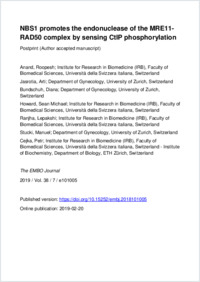NBS1 promotes the endonuclease of the MRE11-RAD50 complex by sensing CtIP phosphorylation
- Anand, Roopesh Institute for Research in Biomedicine (IRB), Faculty of Biomedical Sciences, Università della Svizzera italiana, Switzerland
- Jasrotia, Arti Department of Gynecology, University of Zurich, Switzerland
- Bundschuh, Diana Department of Gynecology, University of Zurich, Switzerland
- Howard, Sean Michael Institute for Research in Biomedicine (IRB), Faculty of Biomedical Sciences, Università della Svizzera italiana, Switzerland
- Ranjha, Lepakshi Institute for Research in Biomedicine (IRB), Faculty of Biomedical Sciences, Università della Svizzera italiana, Switzerland
- Stucki, Manuel Department of Gynecology, University of Zurich, Switzerland
- Cejka, Petr Institute for Research in Biomedicine (IRB), Faculty of Biomedical Sciences, Università della Svizzera italiana, Switzerland - Institute of Biochemistry, Department of Biology, ETH Zurich, Switzerland
-
20.02.2019
Published in:
- The EMBO Journal. - 2019, vol. 38, no. 7, p. e101005
English
DNA end resection initiates DNA break repair by homologous recombination. MRE11-RAD50-NBS1 and phosphorylated CtIP perform the first resection step by MRE11-catalyzed endonucleolytic DNA cleavage. Human NBS1, more than its Xrs2 homologue from Saccharomyces cerevisiae, is crucial for this process, highlighting complex mechanisms that regulate the MRE11 nuclease in high eukaryotes. Using a reconstituted system, we show here that NBS1, through its FHA and BRCT domains, functions as a sensor of CtIP phosphorylation. NBS1 then activates the MRE11-RAD50 nuclease through direct physical interactions with MRE11. In absence of NBS1, MRE11-RAD50 exhibits a weaker nuclease activity, which requires CtIP but not strictly its phosphorylation. This identifies at least two mechanisms by which CtIP promotes MRE11: a phosphorylation-dependent mode through NBS1, and a phosphorylation-independent mode without NBS1. In support, we show that limited DNA end resection in absence of the FHA and BRCT domains of NBS1 occurs in vivo. Collectively, our data suggest that NBS1 restricts the MRE11- RAD50 nuclease to S-G2 phase when CtIP is extensively phosphorylated. This defines mechanisms that regulate the MRE11 nuclease in DNA metabolism.
- Language
-
- English
- Classification
- Biology, life sciences
- License
-
License undefined
- Open access status
- green
- Identifiers
-
- RERO DOC 324588
- DOI 10.15252/embj.2018101005
- ARK ark:/12658/srd1318871
- Persistent URL
- https://n2t.net/ark:/12658/srd1318871
Statistics
Document views: 175
File downloads:
- Fulltext: 349
